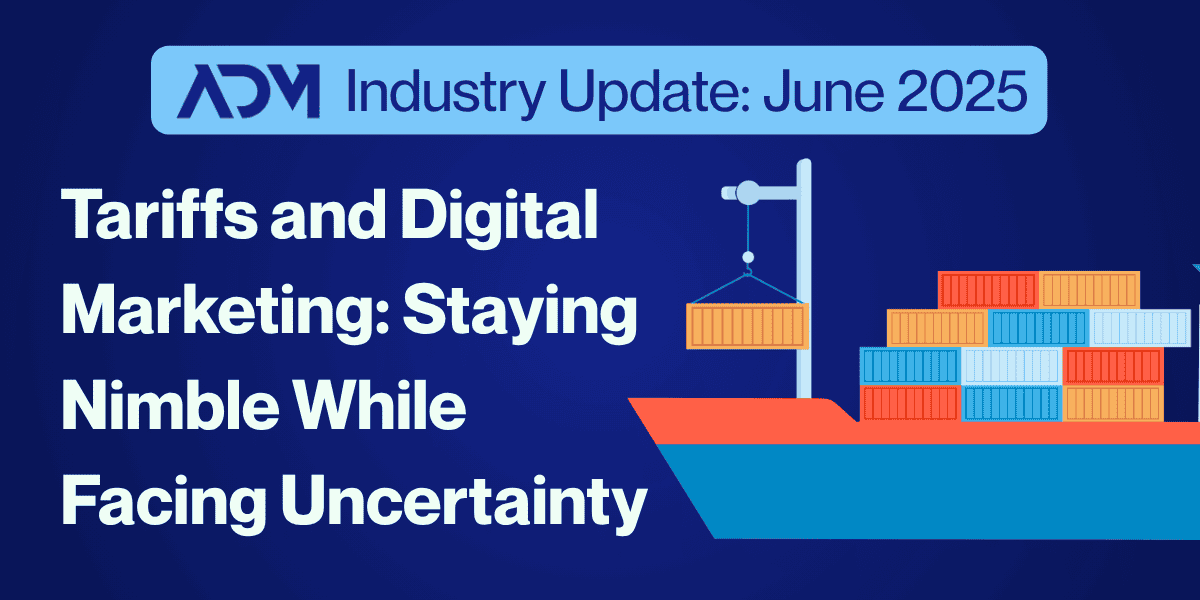While digital marketing is always subject to disruption, it seems like the industry is currently facing more disruption from more sources than typical. As we move into June 2025, we’re focusing on challenges posed by an on-again-off-again global trade war that has caused plenty of confusion for both consumers and companies. In this blog, we’ll discuss the impact tariffs may have on digital marketing and buying habits while also sharing some of the advice we’ve been giving to our clients.
The Effect of Tariffs on Digital Marketing
As tariff uncertainty rattles through the global markets, brands are waiting with bated breath to see what will come next. They’re also trying to determine how to frame their advertising to assuage weary consumers.
Walmart’s recent announcement about raising prices this quarter due to tariffs is a shot across the bow for direct-to-consumer, eCommerce brands, and really anyone who sells anything. If one of the world’s biggest retailers is feeling the pressure, it’s safe to say most other brands will, too—especially those that lean on imported goods, run on tight margins, or, as is often the case, both.
Though there has been some diplomatic progress between the U.S. and China, it doesn’t fully alleviate concerns about pricing and product availability. Competing court cases may impact their fate. Uncertainty is the baseline right now, and hoping everything smooths itself out isn’t exactly a sustainable approach. No matter the outcome, it’s a reminder that brands need to solidify their advertising with clear messaging and strategy for confusing times.
How ADM Is Advising Its Clients
At ADM, we work with our fair share of eCommerce and B2B clients. When economic turbulence arises, we encourage brands to take control of the story proactively—before pricing concerns turn into conversion issues.
Managing Budgets
Keep a Close Eye on Competition and Results: One way to stay proactive is to leverage Google Merchant Center’s price comparison tools. These can be used to flag SKUs that are getting outpriced in Google Ads auctions or on the search engine results page (SERP). From there, you can dynamically update your product feed logic to focus spend on the products that are the most price-relevant at that time. Many companies sell the end products of a patchwork international supply chain, meaning that tariffs will impact different elements of their product lineups in different ways. In that case, your response may involve shifting budget to higher-margin items or those least-impacted by price increases.
Consider Seasonal Impacts: Likewise, there’s a seasonality factor. Brands that focus on different product sets during different periods of the year—like apparel brands—may have already filled their orders for the coming months. Items being ordered now might be intended for retail in Q4. Even if the tariff era doesn’t last long, its impact could ripple for a while. You should be having close conversations with your digital marketing team that consider not just the short-term approach, but contingencies for the holiday season and beyond.
Target Audiences Less Likely to Be Impacted: Some platforms, like Meta Ads, do allow ad targeting based on income categories. If it makes sense for your product category, it might be worthwhile to consider shifting some spend to higher-income audiences who may have fewer reservations about continuing to spend if prices rise.
Make the Right Decisions for Your Bottom Line: Some brands will inevitably consider decreasing their ad buying—more than 40% of brands reportedly expect to. That’s a difficult decision that must factor the company’s profit margins and how uniquely impacted it will be by the tariffs. If it has to happen, you should focus your budget on the products and techniques that deliver the best return on ad spend (ROAS) to maintain efficiency while you wait for the winds to shift again.
Messaging and Landing Pages
Budget’s a big deal, but messaging absolutely matters, too. Sudden price jumps without acknowledgement or additional narrative might be a formula for trouble.
Be Creative: We’ve seen brands take some interesting approaches to rising prices due to tariffs. One cleverly-crafted social media ad used a “We’re saying goodbye…” letter format—as if the advertiser were closing its doors—and instead used the text of the letter to explain that tariffs meant they were saying goodbye to some sale prices. This both captures attention and creates urgency around a limited-time sale.
Look for Competitive Advantages: In another case, we worked with a novel client who may stand to benefit from tariffs. They provide a digital replacement for a traditionally-analog product, so we began to advertise their product as a better alternative to the traditional option because it won’t be subject to external price increases. Those social advertisements have produced excellent top-of-funnel engagement in early testing.
Position Your Products When Possible: With the focus of the tariffs (ostensibly) being to spur domestic production and consumption, we’ve advised some clients to lean into messaging around domestic production when applicable. That includes embracing “Made in the USA” ad copy and building accompanying landing pages for eligible SKUs to reassure customers around availability, value, and stability, tap into growing consumer interest in domestic goods, and control the price/value narrative before customers ask questions.
In one case, we recently recommended a client test this approach by building a dedicated “Made in the USA” landing page. The content highlighted domestic sourcing for relevant SKUs and addressed growing concerns about tariffs and price sensitivity. From there, we launched a targeted, cross-channel effort to drive qualified traffic to that page and reinforce the message across the funnel.
Compared to broader account benchmarks, these SKUs saw:
- +141% click-through rate
- +63% return on ad spend
- +123% average order value
The effort produced a slightly higher cost-per-click (+10%), a very digestible tradeoff in exchange for much-improved top-of-funnel and middle-of-funnel engagement. In confusing times, this test showed that aligning site experience, ad copy, and feed data around a timely value prop can significantly lift performance across the board.
The Takeaway
When uncertainty swirls, the best thing you can do not panic—instead, plan ahead and get creative. Tariffs, sourcing volatility, and margin pressure aren’t going anywhere, and even when this storm blows over, another one will be soon to come. But strategic messaging, a flexible site and landing page experience, and real-time pricing visibility are all levers brands can pull right now to stay competitive, build trust, and stay top-of-mind.
If you’re looking for a dynamic digital marketing agency that can help you strategize for whatever comes next, don’t hesitate to reach out to the team here at ADM for a conversation.



